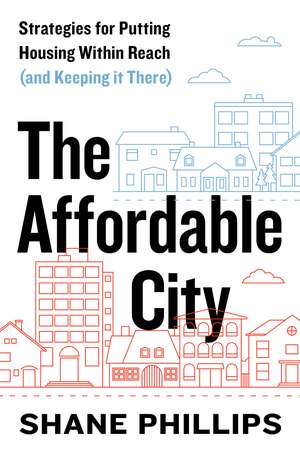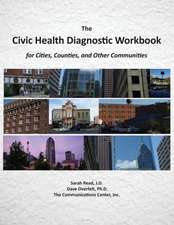The Affordable City: Strategies for Putting Housing Within Reach (and Keeping it There)
Autor Shane Phillipsen Limba Engleză Paperback – 15 sep 2020
Shane Phillips believes that effectively tackling the housing crisis requires that cities support both tenant protections and housing abundance. He offers readers more than 50 policy recommendations, beginning with a set of principles and general recommendations that should apply to all housing policy. The remaining recommendations are organized by what he calls the Three S’s of Supply, Stability, and Subsidy. Phillips makes a moral and economic case for why each is essential and recommendations for making them work together.
There is no single solution to the housing crisis—it will require a comprehensive approach backed by strong, diverse coalitions. The Affordable City is an essential tool for professionals and advocates working to improve affordability and increase community resilience through local action.
Preț: 222.97 lei
Nou
Puncte Express: 334
Preț estimativ în valută:
42.68€ • 43.98$ • 36.03£
42.68€ • 43.98$ • 36.03£
Carte disponibilă
Livrare economică 11-25 februarie
Livrare express 25-31 ianuarie pentru 26.12 lei
Preluare comenzi: 021 569.72.76
Specificații
ISBN-13: 9781642831337
ISBN-10: 1642831336
Pagini: 280
Dimensiuni: 152 x 229 x 15 mm
Greutate: 0.43 kg
Editura: Island Press
Colecția Island Press
ISBN-10: 1642831336
Pagini: 280
Dimensiuni: 152 x 229 x 15 mm
Greutate: 0.43 kg
Editura: Island Press
Colecția Island Press
Notă biografică
Shane Phillips is an urban planner and policy expert based in Los Angeles. He is currently managing the UCLA Lewis Center Housing Initiative and teaching public policy as an adjunct instructor at the University of Southern California. Phillips previously worked as the Director of Public Policy for Central City Association, a Downtown LA advocacy organization. He writes about housing and transportation policy at Better Institutions (www.betterinstitutions.com).
Cuprins
Introduction
Part I: Principles and General Recommendations
1. Pursue the Three S’s (Supply, Stability, and Subsidy) Simultaneously
2. Take Action Now
3. Focus on Institutional Reform
4. Adapt Solutions to the Needs of Your Community
5. Center Voices of, and Outcomes for, the Disenfranchised and Most Vulnerable
6. Use a Mix of Mandates and Incentives
7. Know What You’re Asking For
8. Pick One: Rising Home Values or Housing Affordability
9. Don’t Reward Idle Money
10. Don’t Coddle Landlords
11. Track Everything
12. Strive for Objective, Consistent Rules
13. Expand the Conversation around Gentrification
14. Align Local Votes with Presidential and Midterm Elections
Part II: Policies
Supply: Why Housing Matters
15. Upzone a Lot (Upzoning: High Capacity)
16. Upzone Many Places at Once (Upzoning: Geographically Distributed)
17. Focus Upzones in Accessible and High-Opportunity Areas (Upzoning: Targeted)
18. Find the Upzoning Sweet Spot: Not Too Big, Not Too Small (Upzoning: Rightsized)
19. Allow Housing in Commercial Zones (Mixed-Use Zoning)
20. Make It Expensive to Reduce the Supply of Homes (Home Sharing)
21. Eliminate Density Limits in Most Places (Density Limits)
22. Eliminate Parking Requirements Everywhere (Parking Minimums)
23. Let Renters Decide What They Value (Micro-units)
24. Make Development Approvals “By Right” (By-Right Development)
25. Speed Up the Entitlement Process (Faster Approvals)
26. Explore Other Ways to Bring Down Development Costs (Input Costs)
27. Promote Counter-cyclical Home Building (Counter-cyclical Development)
Stability: Why Tenant Protections and Rental Housing Preservation Matter
28. Place Moderate Restrictions on Rent Increases for Nearly All Housing (Anti-Gouging)
29. Place Stronger Restrictions on Rent Increases for Older Housing (Rent Stabilization)
30. Be Careful with Vacancy Control
31. Implement Inclusionary Zoning and Density Bonuses
32. Discourage Redevelopment That Requires Renter Displacement (Displacement Compensation and Right of Return)
33. Implement Replacement Housing Mandates
34. Make Affordability Requirements Permanent (Affordability Covenant Duration)
35. Buy Naturally Occurring Affordable Housing with Public Funds
36. Require Transparency from Voluntary Tenant Buyouts
37. Prioritize Displaced Tenants for Affordable Housing Placement (Preferential Placement)
38. Limit the Ability of Landlords to “Go Out of Business” (Rental Housing Preservation)
39. Use Just-Cause Protections to Discourage Evictions
40. Require Government Notification for All Eviction Notices and Rent Hikes (Landlord Transparency)
41. Offer Free or Reduced-Cost Legal Counsel to Residents Facing Eviction (Right to Counsel)
42. Enforce Housing and Building Codes
43. Eliminate Discrimination against People with Housing Choice Vouchers
44. Prioritize Stability over Wealth Creation (Homeownership Assistance)
Subsidy: Why Government Spending and Public Programs Matter
45. Institute a Progressive Tax on Home Sales (Real Estate Transfer Tax)
46. Tax “Flipped” Houses at Higher Rates
47. Utilize Property Taxes
48. Tax Underutilized and Vacant Property
49. Don’t Sell Public Land; Lease It (Public Land and P3s)
50. Minimize Impact Fees and Charge Them Equitably
51. Don’t Let Small Buildings off the Hook (Missing Middle)
52. Reform or Eliminate Most Homeowner Subsidies
53. Reform and Increase Funding for Affordable Housing Construction
54. Increase Funding for Direct Rental Assistance
55. Fund Low- and Zero-Interest Loans for Housing Acquisition and Development
Part III: Bringing It All Together
Conclusion
Appendix: Development and Real Estate Economics 101
Part I: Principles and General Recommendations
1. Pursue the Three S’s (Supply, Stability, and Subsidy) Simultaneously
2. Take Action Now
3. Focus on Institutional Reform
4. Adapt Solutions to the Needs of Your Community
5. Center Voices of, and Outcomes for, the Disenfranchised and Most Vulnerable
6. Use a Mix of Mandates and Incentives
7. Know What You’re Asking For
8. Pick One: Rising Home Values or Housing Affordability
9. Don’t Reward Idle Money
10. Don’t Coddle Landlords
11. Track Everything
12. Strive for Objective, Consistent Rules
13. Expand the Conversation around Gentrification
14. Align Local Votes with Presidential and Midterm Elections
Part II: Policies
Supply: Why Housing Matters
15. Upzone a Lot (Upzoning: High Capacity)
16. Upzone Many Places at Once (Upzoning: Geographically Distributed)
17. Focus Upzones in Accessible and High-Opportunity Areas (Upzoning: Targeted)
18. Find the Upzoning Sweet Spot: Not Too Big, Not Too Small (Upzoning: Rightsized)
19. Allow Housing in Commercial Zones (Mixed-Use Zoning)
20. Make It Expensive to Reduce the Supply of Homes (Home Sharing)
21. Eliminate Density Limits in Most Places (Density Limits)
22. Eliminate Parking Requirements Everywhere (Parking Minimums)
23. Let Renters Decide What They Value (Micro-units)
24. Make Development Approvals “By Right” (By-Right Development)
25. Speed Up the Entitlement Process (Faster Approvals)
26. Explore Other Ways to Bring Down Development Costs (Input Costs)
27. Promote Counter-cyclical Home Building (Counter-cyclical Development)
Stability: Why Tenant Protections and Rental Housing Preservation Matter
28. Place Moderate Restrictions on Rent Increases for Nearly All Housing (Anti-Gouging)
29. Place Stronger Restrictions on Rent Increases for Older Housing (Rent Stabilization)
30. Be Careful with Vacancy Control
31. Implement Inclusionary Zoning and Density Bonuses
32. Discourage Redevelopment That Requires Renter Displacement (Displacement Compensation and Right of Return)
33. Implement Replacement Housing Mandates
34. Make Affordability Requirements Permanent (Affordability Covenant Duration)
35. Buy Naturally Occurring Affordable Housing with Public Funds
36. Require Transparency from Voluntary Tenant Buyouts
37. Prioritize Displaced Tenants for Affordable Housing Placement (Preferential Placement)
38. Limit the Ability of Landlords to “Go Out of Business” (Rental Housing Preservation)
39. Use Just-Cause Protections to Discourage Evictions
40. Require Government Notification for All Eviction Notices and Rent Hikes (Landlord Transparency)
41. Offer Free or Reduced-Cost Legal Counsel to Residents Facing Eviction (Right to Counsel)
42. Enforce Housing and Building Codes
43. Eliminate Discrimination against People with Housing Choice Vouchers
44. Prioritize Stability over Wealth Creation (Homeownership Assistance)
Subsidy: Why Government Spending and Public Programs Matter
45. Institute a Progressive Tax on Home Sales (Real Estate Transfer Tax)
46. Tax “Flipped” Houses at Higher Rates
47. Utilize Property Taxes
48. Tax Underutilized and Vacant Property
49. Don’t Sell Public Land; Lease It (Public Land and P3s)
50. Minimize Impact Fees and Charge Them Equitably
51. Don’t Let Small Buildings off the Hook (Missing Middle)
52. Reform or Eliminate Most Homeowner Subsidies
53. Reform and Increase Funding for Affordable Housing Construction
54. Increase Funding for Direct Rental Assistance
55. Fund Low- and Zero-Interest Loans for Housing Acquisition and Development
Part III: Bringing It All Together
Conclusion
Appendix: Development and Real Estate Economics 101
Recenzii
“[The Affordable City] provides pragmatic solutions to the housing affordability crisis facing many cities before the pandemic, which is all but a certainty to last well beyond the final infections.”
"The Affordable City as an excellent jumping-off point for nuanced, difficult, and hopefully, constructive conversations about how we can use policy to create a housing system that meets everyone’s need for a safe, clean and stable home."
"Exceptionally and effectively well written, organized and presented, The Affordable City: Strategies for Putting Housing Within Reach (and Keeping it There) is an extraordinary instructional guide and reference that is especially and unreservedly recommended for community, college, and university library Urban and City Planning/Development collections and supplemental curriculum studies lists."
"The book was written with the intent of making housing policy accessible to anyone who picks it up, and this well-written, highly readable gem does just that."
"The Affordable City is an incredibly thorough review of modern affordable housing initiatives written in a way that can be understood by many. Phillips writes effectively, cohesively, and offers an insightful curation of policies and guidelines…. Housing is a robust and complex topic that must be discussed with curiosity, compassion, and cohesion—Phillips offers all this and more in this book."
Descriere
In The Affordable City, housing expert Shane Phillips argues that to effectively address the housing crisis, cities must support both tenant protections and housing abundance.
Phillips offers more than 50 policy recommendations addressing what he refers to as the “Three S’s” of Supply, Stability, and Subsidy. He makes a moral and economic case for why each is essential and recommendations for making them work together. He ends with a policy blueprint and concise implementation plan for each policy, including whether it should be pursued as an immediate, medium-term, or long-term priority.
The Affordable City is an essential tool for professional city planners, policymakers, public officials, and advocates working to improve affordability and increase community resilience through local action.
Phillips offers more than 50 policy recommendations addressing what he refers to as the “Three S’s” of Supply, Stability, and Subsidy. He makes a moral and economic case for why each is essential and recommendations for making them work together. He ends with a policy blueprint and concise implementation plan for each policy, including whether it should be pursued as an immediate, medium-term, or long-term priority.
The Affordable City is an essential tool for professional city planners, policymakers, public officials, and advocates working to improve affordability and increase community resilience through local action.
















